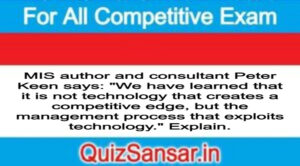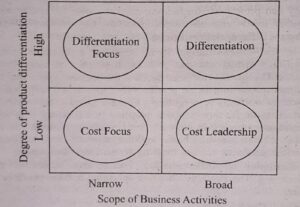
MIS author and consultant Peter Keen says: “We have learned that it is not technology that creates a competitive edge, but the management process that exploits technology.” Explain.
MIS author and consultant Peter Keen says: “We have learned that it is not technology that creates a competitive edge, but the management process that exploits technology.” Explain. Classify different types of competitive forces and competitive strategies.
Ans.
Technology and its related applications are developing at a rapid pace. If organizations are to compete successfully in today’s marketplace, they have little choice but to be behind the eight ball. The management of the technology and the development of innovative ideas are the ingredients that make companies successful today.
Competitive Strategies
Following on from his work analysing the competitive forces in an industry, Michael Porter suggested four “generic” business strategies that could be adopted in order to gain competitive advantage. The four strategies relate to the extent to which the scope of a businesses’ activities are narrow versus broad and the extent to which a business seeks to differentiate its products. The four strategies are summarized in the figure below:

The differentiation and cost leadership strategies seek competitive advantage in a broad range of market or industry segments. By contrast, the differentiation focus and cost focus strategies are adopted in a narrow market or industry.
Strategy Differentiation
This strategy involves selecting one or more criteria used by buyers in a market – and then positioning the business uniquely to meet those criteria. This strategy is usually associated with charging a premium price for the product often to reflect the higher production costs and extra value-added features provided for the consumer. Differentiation is about charging a premium price that more than covers the additional production costs, and about giving customers clear reasons to prefer the product over other, less differentiated products.
Examples of Differentiation Strategy: Mercedes cars; Bang & Olufsen
Strategy – Cost Leadership
With this strategy, the objective is to become the lowest-cost producer in the industry. Many (perhaps all) market segments in the industry are supplied with the emphasis placed minimizing costs. If the achieved selling price can at least equal (or near)the average for the market, then the lowest-cost producer will (in theory) enjoy the best profits. This strategy is usually associated with large-scale businesses offering “standard” products with relatively little differentiation that are perfectly acceptable to the majority of customers. Occasionally, a low-cost leader will also discount its product to maximize sales, particularly if it has a significant cost advantage over the competition and, in doing so, it can further increase its market share.
Examples of Cost Leadership: Nissan; Tesco; Dell Computers
Strategy Differentiation Focus
In the differentiation focus strategy, a business aims to differentiate within just one or a small number of target market segments. The special customer needs of the segment mean that there are opportunities to provide products that are clearly different from competitors who may be targeting a broader group of customers. The important issue for any business adopting this strategy is to ensure that customers really do have different needs and wants in other words that there is a valid basis for differentiation – and that existing competitor products are not meeting those needs and wants.
Examples of Differentiation Focus: any successful niche retailers; (e.g. The Perfume Shop); or specialist holiday operator (e.g. Carrier)
Strategy – Cost Focus
Here a business seeks a lower-cost advantage in just on or a small number of market segments. The product will be basic – perhaps a similar product to the higher-priced and featured market leader, but acceptable to sufficient consumers. Such products are often called “me-too’s”.
Examples of Cost Focus: Many smaller retailers featuring own-label or discounted label products.






